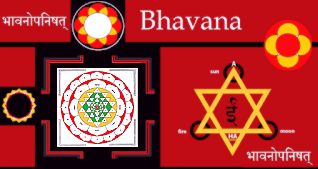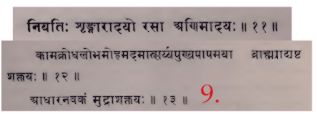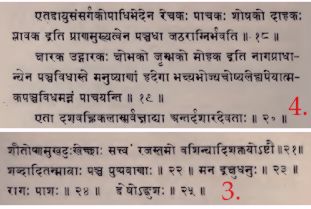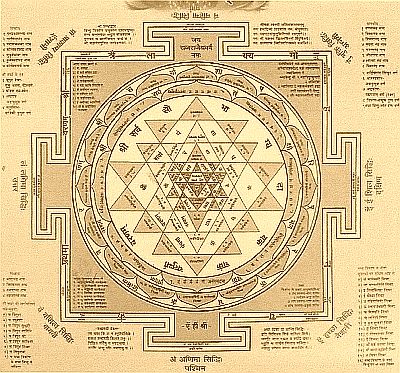Bhavanopanishad

1. Bhavanopanishad is one among the minor Upanishads; and is, comparatively , a recent one. It is listed under the category of Shaktha Upanishads viz. the Upanishads that delineate the tantric outlook and attempt to reconcile that with the Vedic approach. Bhavanopanishad is affiliated to Atharva Veda. It is a major text in the Sri Vidya – Sri Chakra tradition; and, brings out, very crisply, the symbolism of Sri Chakra and its upasana; its spiritual mode of worship of kadi (samaya) school, and contemplation. Bhavanopanishad is an important text for the practice of antar-yaga, the internal worship.

2. Before we proceed further, a brief explanation on the suffix (Upanishad) to the title of the text appears necessary.
As per tradition, about thirteen Upanishads are considered major Upanishads; and they represent the core of the Upanishad wisdom. They are of doubtless antiquity and constitute the first tier of the prasthana-traya (the set of three principal texts), the foundations of the Vedic heritage; the other two tiers being the Brahma Sutras and the Bhagavad-Gita. Sri Shankara commented on ten of those major Upanishads (Ishavasya, Kena, Katha, Prashna, Taittireeya, Aithreya, Chandogya, Brihadaranyaka, Mundaka and Mandukya); and cited the other three (Kaushitaki, Svethavatara and Jabaala) as being authoritative
2.1. During the later times, varieties of texts gave themselves (or were attached with) the suffix-Upanishad –to their title. That was perhaps meant to provide those texts a halo of authority and an elevated position in the hierarchy of traditional texts. The thoughts in most of such texts were neither fresh nor universal. Many of those texts were theistic and sectarian in their approach; and were, therefore, classified according to their affiliations, such as Vaishnava, Shaiva and Shaktha etc. All such Upanishads are enumerated in the Charana-vyuha section of Atharva Veda, to which they are affiliated. That section itself has a supplementary character about it.
Mukthikopanishad (1.5), itself a minor Upanishad affiliated to Atharva Veda, lists about 95 minor (apart from the major 13) Upanishads.
2.2. Their claim to being Upanishads was, generally, based on their acceptance of the authority of the Vedas; rejection of the gross ritualism of karma-kanda; and, highlighting the esoteric or the mystical significance of the rituals.
3. Coming back to Bhavanopanishad; it is described as an Upanishad in the sense of a secret doctrine or a liberating-wisdom.
3.1. Nothing much is known about its author or its period. It is surmised the text may belong to about 12th century.
3.2. Bhavanopanishad is a short text; a collection of aphoristic statements (vakyas) running into just about 36 lines. The statements are in Sutra style; exceedingly cryptic and with no suggestions. It is not easy to interpret the sutras and derive meaning out of them.

3.3. The Bhavanopanishad is closely related to the Tantra-raja-tantra, another major tantric text of the Kadi School of the Sri Vidya tradition. The Kadi_ matha is regarded the most orthodox among all the schools of Sri Vidya tradition. It insists on virtue, discipline and purity of rituals. Its attitude is Sattvic; and its form of worship is internal. Hence Kadi School (also known as Samaya) is regarded as Para Vidya (transcendental knowledge) where the worship (archana) is conducted in the space of one’s heart (hrudayakasha madhye).
4. 1.The main purport of Bhavanopanishad is to establish a relation between structures of the human body and Sri chakra. The Sri Chakra, in turn, is regarded as a projection of the essential characters of the universe. There is an attempt to harmonize (samarasya) the micro (pindanda) and the macro (brahmanda), with Sri Chakra being the median imbibing in itself the characteristics of the both.
Bhavanopanishad lays greater emphasis on symbolic representations and contemplation, than on rituals.
[Please check here for a detailed discussion concerning the relation between the Sri Chakra and human body, as per the Bhavanopanishad ]
4.2. The text begins with salutations and surrender to the Guru, hailing him as the fountainhead of the liberating wisdom. Then it goes on to relate the human constitution in its physical, mental and vital levels to the nine-fold energy represented by the nine enclosures of the Sri Chakra.


A significant portion of the text is devoted to the enumeration of the nine enclosures (avaranas) that compose the Sri Chakra yantra; and to their geometric, cultic and psycho-physical representations. The method of enumeration adopted is the samhara-krama (absorption or dissolution method), which commences from the outermost avarana and proceeds inwards, systematically, till the central point of the Sri Chakra, the Bindu, is reached.
In short, the text attempts to construct a harmonious relation between the micro and the macro; between the Tantric and the Vedic; and between worship and contemplation. It also renders the Tantric worship sattvic and sublime.











[ I acknowledge with thanks the source :
http://gokulpoems.blogspot.com/p/bhavana-upanishad.html ]
5.1. In the Sri Vidya tradition, the concept of Bhavana (after which the text is named) has a very special significance.
In the tantra tradition, the worship is classified as external (bahir-yaga) and internal (antar-yaga).
In the former, the worship is offered to a concrete representation of a divinity which inspires devotion and reverence. Here, the object of adoration and worship is gross (sthula). The devotee looks upon the mother-goddess as having a human form which he can see and touch. The services (upacharas) are offered to that form as if it were the most adorable and highly revered human being. The worship also includes praising the divinity (stuti), repeating the mantra handed down by the Guru (japa), which the tongue can utter and the ears can hear. There is also the contemplation on the glory of the God (dhyana). This form of worship is termed as gross (sthula).
The text says that external worship is only a stepping stone, a preliminary procedure; and, one must go beyond that in due course. The external worship is a means and not an end.
5.2. The other form of worship viz. antar-yaga, the internal worship, is in two stages – with external props (sa-adhara) and without such props (nira-dhara).
The props referred to here are the physical accessories, such as image, gestures (mudra) or sounds. The devotee understands and appreciates the symbolism involved in those objects of adoration and in the ritual sequences. He knows that the props are there to help him and guide him along the path; and yet he submits to them, entirely, with devotion and reverence until the wisdom dawns. His dependence on the props tapers gradually. The worship here tends to be subtle (sukshma).
5.3. The second stage of antar-yaga is transcendental (para), leading to gradual dissolution of mind in intense contemplation and visualization of identity with the mother-goddess. His entire psyche is immersed in the mother principle. Now, the external rites, worships or conducts, no longer carry any meaning, for him.
5.4. The devotee’s consciousness undergoes a transformation with the realization that he and the Mother are one. Such transformation is termed Bhavana. Etymologically, the term is derived from the root bhu (to be) to suggest bringing something into being. It also suggests a mental process that transforms an idea into reality. In an extended sense, the term means contemplation or meditation, comprehending the abstract as real and tangible.
5.5 The expression Bhavana here is taken to mean, internal worship (antar-yaga) of the Devi, visualizing Sri Chakra as identical with one’s own being (sva-atma-shakthi) and offering worship through mental constructs , projections and visualizations. The method of Bhavana is regarded as the sublime form of worship for attaining liberation, even while one is alive (jeevan-mukthi).
6. Bhavana emerged as a very significant concept in the development of the tantric tradition; and, to an extent, it rescued the tantra from totally degenerating into grotesque and abominable cult practices. It came as a breath of fresh air cleansing the polluted atmosphere of the tantra. It helped sublimating the coarse tantric beliefs into universal principles. The advocacy of meditation (bhavana) rendered the tantra acceptable to householders too. It also helped to reconcile the tantra outlook with the Vedic ethos.
7.1. As I mentioned earlier, the Bhavanopanishad is in the form of terse Sutras and it is not easy to understand its import without the aid of a commentary. The most well known of all the commentaries on Bhavanopanishad is The Bashya by Bhaskararaya Makhin, who called himself Saubhagya-bhaskara.
7.2. Bhaskararaya was a celebrated authority on the philosophy and practice of Tantra; and, especially on the Sri Vidya upasana. Though his exact dates are uncertain, it is accepted he lived (between 1690 and 1795) ; mostly during the 18th century. His father Ghambhira Raya was a scholar and served as a minister in the court of the sultan of Bijapur (North Karnataka).His mother’s name is given as Konnamamba; and his place of birth is mentioned as Bhaga-nagar (the present-day Hyderabad in AP).
7.3. He was initiated into tantric worship by his father; and he had the formal initiation and final consecration from the tantric master Shivadatta Shukla of Surat (Guj). He later married Anandi Bai from Maharashtra and initiated her in Sri Vidya. After studying for many years in Varanasi, he returned to the south; and finally settled down in Tiruvalangadu on the banks of the Cauvery in Chola mandala. He was a versatile scholar and a prolific writer with more than forty books in Sanskrit on several branches of learning.
7.4. His commentary on the Bhavanopanishad is brief but well constructed. His explanations are precise and pre supposes familiarity of the reader with the ideologies and concepts of Sri Vidya.
His works are of particular interest to Sri Vidya upasakas, as they furnish practical instructions and information concerning its upasana and sadhana. The more important among such texts are his companion volume to his commentary on Bhavanopanishad; it is called, for short, prayoga-vidhi, a practical manual for worship of Sri Chakra.
His other well-known works concerning Sri Vidya are his commentaries on: Lalitha sahasranama, Tripuropanishad, Kaulopanishad and Lalitha –tripura-sundari Upanishad.

Prof SK Ramachandra Rao in his Lalitharchana Chandrika (Kalpataru Research Acedemy,2004) explains:
The best known work of Bhaskararaya is on Lalita-Sahasranama, constructed on the basis of Lalitopakhyana ,which , in turn, constitutes the last four Chapters (Chapters 41 to 44) of Brahmanda-Purana.
Lalitha-Sahasranama , recounts with awe and reverence, the thousand significant names of the Mother Goddess Lalitha (Lalithamba, Para-shakthi,Parama Bhattarika,Lalitha-Tripurasundari and Rajarajeshwari). The text is constructed over Three Chapters , altogether consisting 320 Verses.
The First Chapter (51 Verses) introduces the Vag-Devathas , headed by Vasinis, who are in the entourage of the Mother Goddess Sri Lalitha. It is, in fact, these Devathas that composed and recited the thousand names of Lalitha , as commanded by the Goddess herself.
The second Chapter (182 1/2 Verses) contains the main text of the One Thousand names of Devi Sri Lalitha.
The Third Chapter (86 1/2 Verses) is in the nature of the epilogue (Phala-stuti) and so on.
The main Nyasa of the Sri Lalitha-Sahasranama is as follows :
asya śrī lalitā divya sahasranāma stōtra mahāmantrasya, vaśinyādi vāgdēvatā ṛṣayaḥ, anuṣṭup Chandaḥ, śrī lalitā parābhaṭṭārikā mahā tripura sundarī dēvatā, aiṃ bījaṃ, klīṃ śaktiḥ, sauḥ kīlakaṃ, mama dharmārtha kāma mōkṣa chaturvidha phalapuruṣārtha siddhyarthē lalitā tripurasundarī parābhaṭṭārikā sahasra nāma japē viniyōgaḥ

[Please check here for Lalita sahasranama a study in the light of the commentary of Bhaskararaya Makhindra – A doctoral thesis by Sri L M Joshi submitted to the Maharaja Sayajirao University of Baroda.
https://shodhganga.inflibnet.ac.in/handle/10603/59361 ]

Bhaskararaya lived to be a very old man and spent his last days at his house on Mahadanapuram Street of Madhyarjuna-kshetra (Tiruvidaimarudur). He passed away at the age of 95.
8. The best known rendering (in English) of Bhaskararaya’s commentary on Bhavanopanishad is by Prof. S K Ramachandra Rao, published by Kalpatharu Research Academy, Bangalore.

Sources and References:
The tantra of Sri Chakra by Prof. S K Ramachandra Rao
Bhavana Upanishad- text in English http://www.hinduwiki.com/index.php?title=Bhavana_Upanishad
Nitya Kala Devis http://www.srividya.org/Srividya/Svtsweb/apps/?act=viewPhoto&photo_id=8
The Fifteen Nityas http://www.religiousworlds.com/mandalam/nitya.htm
Life sketch of Bhaskararaya Makhin http://kamakshi16.tripod.com/bhaskara.html
http://en.wikipedia.org/wiki/Bhaskararaya
(Please click here for a fairly detailed account of Sri Bhaskararaya Makhin’s life)

sreenivasaraos
September 15, 2012 at 3:50 pm
Thank you ellisnelson for the appreciation.
Regards
sreenivasaraos
September 16, 2012 at 12:52 am
Dear Patrick Latter , Thank you.
Regards
sreenivasaraos
September 17, 2012 at 7:49 pm
Dear iGameMom < Thank you . Regards
sreenivasaraos
March 20, 2015 at 11:39 am
sreenivas: i found it very interesting but a little hard going. i read a little of the life of bhaskaraya from the life sketch cited by you, who appeared to have lived in tanjore district. it mentions that bhaskaraya was an admirer of appayya dikshita who also lived in tanjore district two centuries prior to bhaskararaya: my wife is descended directly from appayya through her father. he was an advaitin who lived in the 16th century. was appayya also involved in devi worship and in tantric practices ? also, my wife has inherited my late mother’s sri chakra and prays to it every day. i also recite a devi stotra every day. are there any specified procedures in devi worship ?
rgds,
girdhar
sreenivasaraos
March 20, 2015 at 11:39 am
dear shri gopal,
thank you for reading.
i am sorry. i just revised the mid-portion to make it slightly more readable. i hope it worked.
regarding, sri appayya dikshita, wow… that’s great. he was an advaitin and a great scholar .he authored a large number of texts in almost all branches of learning -sanskrit literature, poetry, rhetoric, philosophy. just as the advaitins of those times, he too had enormous devotion and reverence to the devi. among his works, there is sri vidya tatva vivaranam, a text explaining the sri vidya principles. he also wrote durga chandra kala stuti, fifteen verses singing the glory of sri durga, and praying for protection from poverty, enemies, difficulties, unanticipated disasters and fear from death. it is woven around instances from devimahathmyam, varaha puranam, bhagavatham etc. it employs some sri vidya – tantric terms. i think he later wrote a commentary on that stuti. i heard, those verse are still a part of the usual evening prayers of his descendents. [you might know the correct position.]
regarding the procedures of worship, bhaskararaya wrote a companion volume to bhavanopanishad, it is called, for short, prayoga vidhi, a practical manual for worship of sri chakra. he also wrote a similar work based on lalitha sahasranama. there are of course a number of texts by other authors detailing procedure for sri chakra worship .
regards
sreenivasaraos
March 20, 2015 at 11:41 am
dear sreenivasa rao.. the connection between the macro and the micro the subtle and the grosss a’and the vedic and the tantric and also between mandal and meditation.. the connecting link seems to be this bhavanopanishad.. thanks for the divine knowledge ..
DSampath
sreenivasaraos
March 20, 2015 at 11:41 am
dear shri sampath,
thank you for the comments.
you have a talent for putting things, aptly.
yes sir, as you said , the text, in short, attempts to construct a harmonious relation between the micro and the macro; between the tantric and the vedic; and between ritual worship and contemplation. it also renders the tantric worship sattvic and sublime.
thanks again.
regards
Chakra Yog
October 17, 2015 at 9:39 am
Sounds Interesting… It is very informative and I Like this Post….
sreenivasaraos
October 17, 2015 at 10:23 am
You are welcome Dear Chakra Yog.
I am glad you like this.
Please also read the other posts relating to Sri Chakra
Regards
sreenivasaraos
October 17, 2015 at 10:24 am
You are welcome Dear Chakra Yog.
I am glad you like this.
Please also read the other posts relating to Sri Chakra
Regards
Sujatha Iyengar
March 13, 2017 at 3:58 pm
very nice compilation – after reading this blog I’ve started reading SK Rao’s books -thanks a lot for the information -Muthuswami Dikshitar Nava varna Krithi explanation too super though I’ve not read in totality -Suggest some other good reads on Lalitha
sreenivasaraos
March 14, 2017 at 12:36 am
Dear Sujatha
Thank you for the visit and the appreciation.
As regards the books of Prof. SKR Rao the website maintained by his family
S. K. Ramachandra Rao Memorial Website
gives a list of his books that are now available at
http://profskr.com/?page_id=97
*
On Sri Lalaitha , so far as I know, the books written by Dr. R Satyanarayana are very authentic
You may ( in case you can read Kannada) start with his Sri-Vidya Shodashika
And for his other books ; you may contact him at N0.CH 12. ‘Thrayeelakshmi’, 9th Cross , 4th Main, Jayanagae , Mysore -570014
*
Keep reading and commenting
Regards